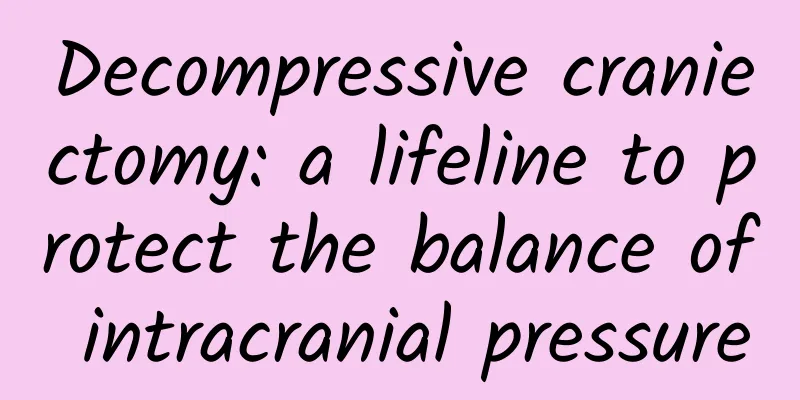Decompressive craniectomy: a lifeline to protect the balance of intracranial pressure

|
Author: Liu Baiyun, Chief Physician, Beijing Tiantan Hospital, Capital Medical University Reviewer: Xiao Weizhong, Chief Physician, Peking University Third Hospital In the vast medical field, neurosurgery has always been known for its complexity and precision. Among them, decompressive craniectomy, as an urgent and critical surgical method for treating intracranial hypertension, plays a vital role in the critical moment of increased intracranial pressure. 1. Principles and operation of decompressive craniectomy Decompressive craniectomy, as the name suggests, is a surgical procedure that removes part of the skull (i.e., craniectomy) to free up space for swollen brain tissue and reduce intracranial pressure. This surgical procedure is usually performed on patients with increased intracranial pressure due to brain trauma, stroke, tumor, or infection. Decompressive craniectomy is divided into internal decompression and external decompression. Internal decompression is aimed at brain lesions, such as tumor resection, to reduce the volume of brain tissue; external decompression is to expand the cranial cavity space, which is achieved by removing the skull flap. With the advancement of medicine, from the initial small bone flap to today's large bone flap surgery, the decompression effect has been significantly improved, providing better treatment options for patients with severe intracranial hypertension. Large bone flap craniotomy has become the preferred method for treating severe intracranial hypertension due to its significant decompression effect. Figure 1 Original copyright image, no permission to reprint At the beginning of the operation, the doctor will choose the appropriate surgical path according to the patient's specific situation, and use a step-by-step ladder-shaped approach, from the scalp and skull to the brain tissue layer by layer. This layer-by-layer approach not only helps to reduce the damage to surrounding tissues during surgery, but is also a specific application of the minimally invasive concept in neurosurgery. Figure 2 Original copyright image, no permission to reprint During the operation, the doctor will remove a large skull flap to fully expose the brain tissue and achieve the purpose of decompression. At the same time, the scalp flap will be expanded accordingly to ensure that the original physiological and anatomical structure can be restored when sutured. When suturing, the doctor will proceed from the inside to the outside, first suturing the dura mater of the brain tissue, then dealing with the skull, and finally suturing the scalp. During this process, the doctor will pay special attention to maintaining the size relationship between the bone flap and the scalp, ensuring that the bone flap is larger than the brain tissue and the scalp is larger than the bone flap, in order to meet the requirements of human physiology and anatomy. It is worth mentioning that after craniotomy and decompressive craniectomy, patients often need cranial repair surgery. When performing cranial repair, doctors will pay special attention to the size of the scalp flap to avoid increasing surgical risks and affecting the healing ability of the scalp due to a scalp flap that is too small. 2. Timing and indications for decompressive craniectomy The timing and indications of decompressive craniectomy should be determined according to the patient's specific condition. In emergency situations, surgery should be performed every second to save lives. For patients with significantly increased intracranial pressure, who are ineffective with conservative treatment, or in cases where the risk of postoperative brain swelling is expected to be high, immediate surgery is necessary. However, because decompressive craniectomy is often performed in emergency situations, the requirements for fasting and drinking may be different. In elective surgery, patients are usually asked to abstain from water for 6 hours and fast for 12 hours before surgery to ensure the safety of the surgical procedure. However, in emergency situations, such as decompressive craniectomy, the requirement to abstain from water may be flexibly adjusted according to the patient's specific condition and surgical needs. For patients undergoing emergency surgery, if waiting for fasting water may cause the condition to worsen or endanger life, doctors may decide to perform surgery without fasting water. Although there are certain risks in doing so, such as vomiting or aspiration, in an emergency, saving lives is the top priority. Figure 3 Original copyright image, no permission to reprint 3. The role and effect of decompressive craniectomy The main purpose of decompressive craniectomy is to reduce intracranial pressure, relieve symptoms and save patients' lives. When intracranial pressure increases, patients may experience symptoms such as headache, vomiting, and impaired consciousness, which may even be life-threatening in severe cases. Through decompressive craniectomy, doctors can provide additional space for swollen brain tissue and reduce intracranial pressure, thereby relieving patients' symptoms and improving their quality of life. In addition, decompressive craniectomy can also create favorable conditions for subsequent treatment. For example, in the case of brain trauma or cerebral hemorrhage, by reducing intracranial pressure, the degree of brain tissue damage can be reduced, providing a better foundation for subsequent neurological rehabilitation treatment. In the case of tumors or infections, by removing diseased tissue and decompressing craniectomy, more space can be provided for subsequent chemotherapy, radiotherapy or anti-infection treatment, improving the treatment effect. |
<<: Intracranial pressure: the invisible guardian of brain health
>>: What is amyloidosis? What happens if it affects the kidneys?
Recommend
What should I do if I have menstrual disorders during adolescence?
Some girls tend to have their periods once every ...
Brown and light menstruation
Normal menstruation should be bright red or dark ...
Can I eat kelp after a miscarriage?
Kelp is a kind of food that many people like in l...
Can you eat vinegar during confinement? Expert advice
Many people know that there are many dietary matt...
What to use to remove makeup for red bloodshot skin
In our daily life, many people have very sensitiv...
Can I have a gynecological examination if my period is not over?
Can I have a gynecological examination before my ...
Can exercise make your breasts bigger?
A devilish figure does not come from being thin, ...
What is the cause of nausea and vomiting due to delayed menstruation?
There are many reasons for women's delayed me...
What is the standard weight for a girl who is 153cm tall?
Girls attach great importance to their weight. In...
Don't be afraid of spotting during the fourth month of pregnancy
In the fourth month of pregnancy, vaginal bleedin...
What is the reason for acne on the face when I am four months pregnant?
Many women always have some problems when they ar...
Pregnant women can smell Huang Daoyi Huoluo Oil
Huang Daoyi Active Oil was developed by an old do...
Amniotic fluid embolism can be completely prevented. Do you do this?
Amniotic fluid embolism is extremely dangerous an...
What should I do if I have an abortion and have sex?
If you don't take good care of your body afte...









![[Medical Q&A] Can birth defects be prevented?](/upload/images/67f0f1e4ee9dd.webp)